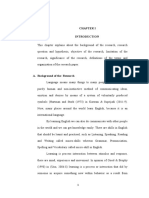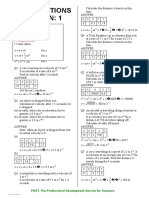Poster Assignment - 1
Poster Assignment - 1
Uploaded by
Henry OsborneCopyright:
Available Formats
Poster Assignment - 1
Poster Assignment - 1
Uploaded by
Henry OsborneOriginal Title
Copyright
Available Formats
Share this document
Did you find this document useful?
Is this content inappropriate?
Copyright:
Available Formats
Poster Assignment - 1
Poster Assignment - 1
Uploaded by
Henry OsborneCopyright:
Available Formats
Comparing the learning strategies used by extravert and introvert ESL
learners in Australia
Siqi Han (u3199842) and Fransisca Budayanti (u3199464)
Tesol and Efl Program, University of Canberra
Introduction b. Learning strategy Conclusion
There are many international students in There are many definition of learning strategy (see Rubin, 1975; -The research in personality and learning strategy does
Oxford, 1999; Weinsten et al, 2000; Cohen, 1998). Rubin (1975) not always show a clearly defined relationship. Personality
Australia who study English courses to
perhaps gave more general and comprehensive definition; variable seems consistently more related to
meet the language requirement of conversational (communicative) skill rather than to
learner strategy as the techniques or devices which learner
universities. Successful learning is grammatical accuracy (Lightbown and Spada, 2018). The
may use to acquire knowledge.
expected in order to obtain required score Instrument such as MSLQ (Motivated Strategies for Learning relationship was more consistent when the studies were
to enter the Australian Universities. Questionnaire), SILL (Strategy Inventory for Language conducted in finding correlation between extravert trait
Personality is one of many factors in ID Learning), Language Strategy Use Inventory and RSCvoc (Self and communication skill.
that explain differential success in L2 Regulating Capacity in Vocabulary Learning Scale are -This study is an attempt to relate the personality trait and
learning. Common perception is that developed to assess learners’ learning strategy. This research learning strategy with both qualitative and quantitative
will use the SILL (Oxford, 1990). data in order to explore more the relationship between
people who has extraverted trait learn
individual differences in second language acquisition.
better than the introverted. However, the Research question/interest -Despite the contradictory results, many researchers still
findings related to introvert and extravert What learning strategies do the introvert and extravert learners believe that personality trait have important influence in
in language learning are mixed. The recent apply to support their language learning? language learning (Lightbown & Spada, 2018; Dornyei,
studies in extravert and introvert in L2 has Are the strategies the introverts used different to the strategy 2005; Dornyei 2015; Larsen-Freeman, 1991).
of the extraverts? If any, what are the differences?
started to explore how these traits are -The findings will hopefully benefit both the learners and
Which learning strategies are most effective for introverted and the teachers. The learners’ awareness of their personality
affecting the learners learning strategy. extraverted learners respectively ?
Many other studies attempted to relate the will lead to awareness of how they will learn best to
achieve success in their L2 learning. Teachers can apply
learning strategy to other ID factors. The
different material, activity and task to adjust with
aim of this study is to investigate the learners’ learning strategy and personality in order
learning strategies used by learners with improve learners’ L2 learning and outcome.
extravert and introvert trait at UC College
in Canberra, Australia, and to compare the
differences of the two types of learners.
References
Burger, J. M. (2004). Personality (6th ed.). CA, USA:
Wadsworth/Thompson Learning.
Literature review Dornyéi, Z. (2005). The psychology of the language learner:
Methodology Individual differences in second language acquisition.
a. Introvert and extravert
Two instrument – the Eysenck Personality Questionnaire NJ, USA: Routledge.
-“A trait is a dimension of personality used to (EPQ) and the Strategy Inventory for Second Language Dornyéi, Z., & Ryan, S. (2015). The psychology of the
categorize people according to the degree to Learning (Oxford, 1990) will be used in this study. language learner revisited. Oxon, UK: Routledge.
which they manifest a particular characteristic Eysenck, H. J., & Eysenck, M. W. (1968). Personality and
(Burger, 2004).” The EPQ will be analyzed on the basis of strategy individual differences: A natural science approach. NY,
classifications suggested by Oxford (1990). Interview will be USA: Plenum Press.
-Typical extravert is someone who is sociable, conducted to collect qualitative data on learners’ learning
take chances, has many friends, enjoy social Griffiths, C. (2008). Lessons from good language learners.
strategy. Furthermore, in order to study which learning Cambridge, UK: Cambridge University Press.
activities, apt to become conventional and strategies are most effective for the two different types of
outgoing. Larsen-Freeman, D., & Long, M. H. (1991). An introduction
learners, a data collection on the students’ English academic to second language acquisition research. Essex, UK:
-On the other hand, introverts are quiet, scores is needed. Pearson Education Limited.
retiring, keep feeling under close control, The participants are 20 students from UC College, and in order Lightbown, P. M., & Spada, N. (2018). How languages are
reliable and has high ethical standard. They to ensure the diversity and representativeness of samples, learned (4th ed.). Oxford, UK: Oxford University Press.
are reserved and distant except to intimate they are chosen from different level of English classes. The Matthews, G., Deary, I. J., & Whiteman, M. C. (2003).
friends (Eysenck & Eysenck, 1968; Mathew et gender and nationality mix is also desired in the selection of Personality trait (2nd ed.). NY, USA: Cambridge
al, 2003; Michael et al, 2004). samples. University Press.
-Trait researchers are interested in predicting Mischel, W., Smith, R. E., & Shoda, Y. (2004). Introduction
how people score with a certain trait will to personality: toward intergration (7th ed.). NY, USA:
You might also like
- Life On Mars Poems by Tracy K Smith 1555975844 PDFDocument5 pagesLife On Mars Poems by Tracy K Smith 1555975844 PDFMonica Montero0% (1)
- 4-Sentence Formula: PTE Describe Image TemplateDocument3 pages4-Sentence Formula: PTE Describe Image TemplateHenry Osborne100% (1)
- The Compilation and Reliability of London Directories, 1989Document15 pagesThe Compilation and Reliability of London Directories, 1989Peter J. AtkinsNo ratings yet
- Need More Literature Support ? Findings From WhereDocument5 pagesNeed More Literature Support ? Findings From WhereHenry OsborneNo ratings yet
- Impact of Personality Traits and Gender Differences On Language Learning StrategiesDocument30 pagesImpact of Personality Traits and Gender Differences On Language Learning StrategiesRuth WanjiruNo ratings yet
- Synthesis Matrix of RRL 1.0Document33 pagesSynthesis Matrix of RRL 1.0Angelbert P. Cu�adoNo ratings yet
- Psycho UTS Rezky RamdhanyDocument12 pagesPsycho UTS Rezky RamdhanynismaraNo ratings yet
- SURTEES FrontiersXXVII BeliefsAboutLanguageLearninginStudyAbroadDocument19 pagesSURTEES FrontiersXXVII BeliefsAboutLanguageLearninginStudyAbroadwasineetip.raiNo ratings yet
- Article Review On The Relationship Between Students' Learning Styles and Their Academic AchievementDocument4 pagesArticle Review On The Relationship Between Students' Learning Styles and Their Academic AchievementDesithaNo ratings yet
- Thesis 1 Concept PaperDocument47 pagesThesis 1 Concept PaperDivineFalalimpaSanzNo ratings yet
- EFL Learners Learning Styles and Their Attributes PDFDocument23 pagesEFL Learners Learning Styles and Their Attributes PDFزيدون صالحNo ratings yet
- Ed 376707Document4 pagesEd 376707109MARIO SOEMAWINATANo ratings yet
- A Comparative Analysis On Extrovert and IntrovertDocument8 pagesA Comparative Analysis On Extrovert and Introvertimamalansyari6No ratings yet
- LS FLAnnalsDocument12 pagesLS FLAnnalsAlwi ZikraNo ratings yet
- 15 Effectsof PDFDocument6 pages15 Effectsof PDFIJELS Research JournalNo ratings yet
- 4 Indah DamayantiDocument6 pages4 Indah DamayantiXCelloNo ratings yet
- The Relationship Between Motivational Systems and Second LanguageDocument5 pagesThe Relationship Between Motivational Systems and Second Languagewasineetip.raiNo ratings yet
- The Diaries of ESL Learners: A Fresh Look at Language Learning ExperienceDocument9 pagesThe Diaries of ESL Learners: A Fresh Look at Language Learning Experiencefairus100% (1)
- The Learning Style Preferences of ESL StudentsDocument26 pagesThe Learning Style Preferences of ESL StudentsIstván LauraNo ratings yet
- A Diary Study Focusing On Listening and Speaking The Evolving Inter - 2014 - SyDocument13 pagesA Diary Study Focusing On Listening and Speaking The Evolving Inter - 2014 - SyMarcelo AndradeNo ratings yet
- R2. Hitt, L. and Véliz, M. (2015)Document24 pagesR2. Hitt, L. and Véliz, M. (2015)Tati KatiukisNo ratings yet
- Differentiated Instruction and Multiple Intelligences As Predictors of Bsed Englsih Students Learning Style 1Document80 pagesDifferentiated Instruction and Multiple Intelligences As Predictors of Bsed Englsih Students Learning Style 1Christine SusasNo ratings yet
- 2993 16090 1 PBDocument8 pages2993 16090 1 PBtianNo ratings yet
- Ejemplos de Fichas Bibliográficas para Temas y para Estudios - MADDocument4 pagesEjemplos de Fichas Bibliográficas para Temas y para Estudios - MADGina Lisseth Tapia ToroNo ratings yet
- Personality Types and Languages Learning Strategies: Chameleons Changing ColoursDocument11 pagesPersonality Types and Languages Learning Strategies: Chameleons Changing Coloursabdelwahed aousjiNo ratings yet
- Learner Engagement and Language Learning: A Narrative Inquiry of A Successful Language LearnerDocument16 pagesLearner Engagement and Language Learning: A Narrative Inquiry of A Successful Language LearnerĐức Duy Trần HuỳnhNo ratings yet
- Module 1 - Fundamentals of Language Education ResearchDocument7 pagesModule 1 - Fundamentals of Language Education Researchmarvin paz67% (3)
- Final List of ReferencesDocument8 pagesFinal List of Referencesapi-658473084No ratings yet
- Adult ESL LearningDocument11 pagesAdult ESL LearningIan SignerNo ratings yet
- And Strategies: Language Learning StylesDocument8 pagesAnd Strategies: Language Learning StylesHenry OsborneNo ratings yet
- Learning Strategy and Learning Style Affecting Second Language AcquisitionDocument34 pagesLearning Strategy and Learning Style Affecting Second Language AcquisitionAkbar D'al-tarraNo ratings yet
- ELT Journal Volume 61 Issue 2 2007 (Doi 10.1093 - Elt - ccm002) Rao, Z. - Training in Brainstorming and Developing Writing SkillsDocument7 pagesELT Journal Volume 61 Issue 2 2007 (Doi 10.1093 - Elt - ccm002) Rao, Z. - Training in Brainstorming and Developing Writing SkillsTamaraNo ratings yet
- 1 PBDocument18 pages1 PBliujinglei3No ratings yet
- EG 531 MA CELS - Anthrogogy - Elective - Final VersionDocument5 pagesEG 531 MA CELS - Anthrogogy - Elective - Final VersionMaseera firdous ShaikNo ratings yet
- Age Differences in The Use of Language Learning StrategiesDocument8 pagesAge Differences in The Use of Language Learning StrategiesTri SulastriNo ratings yet
- In Today's Lecture: Second Language Acquisition For TeachersDocument5 pagesIn Today's Lecture: Second Language Acquisition For TeachersHollós DávidNo ratings yet
- Extroversión - Introversión y AprendizajeDocument8 pagesExtroversión - Introversión y AprendizajeBetsi MartinNo ratings yet
- Bab 1 Dan 2 3 4 5.OKDocument38 pagesBab 1 Dan 2 3 4 5.OKYuni RestiaNo ratings yet
- Self AfficacyDocument13 pagesSelf AfficacyOxtapianusTawarikNo ratings yet
- 03 PDFDocument9 pages03 PDFTati MuflihahNo ratings yet
- Foundations in EFL ResearchDocument9 pagesFoundations in EFL ResearchStephanie PinillaNo ratings yet
- Module 1 - Language Education ResearchDocument12 pagesModule 1 - Language Education ResearchJohn Michael Manjares50% (2)
- Research ProposalDocument25 pagesResearch ProposalCharie Mae GagapNo ratings yet
- Learning Strategies As Bias Factors in Language Test Performance: A StudyDocument13 pagesLearning Strategies As Bias Factors in Language Test Performance: A StudyIJ-ELTSNo ratings yet
- Zhengdong GanDocument16 pagesZhengdong Ganapi-3771376No ratings yet
- Gaerlan Research Dlsuuuuuuuuuuryd JJDocument8 pagesGaerlan Research Dlsuuuuuuuuuuryd JJmarylou riveraNo ratings yet
- Learning and Individual Di FferencesDocument10 pagesLearning and Individual Di FferencesSouhir KriaaNo ratings yet
- Kormos 2013Document25 pagesKormos 2013RACHEL verrioNo ratings yet
- Direct IndirectDocument42 pagesDirect IndirectJason CooperNo ratings yet
- Willingness To Communicate in EnglishDocument8 pagesWillingness To Communicate in EnglishJonathan CifuentesNo ratings yet
- 04-Ed-Huynh Ngoc Tuyen (20-30)Document11 pages04-Ed-Huynh Ngoc Tuyen (20-30)Trung Kiên NguyễnNo ratings yet
- Portfolio Week 1 - Le Thi Nhat BinhDocument8 pagesPortfolio Week 1 - Le Thi Nhat BinhLê Thị Nhật Bình (FE PTCD HN)No ratings yet
- Chapter: 2 Review of The Related LiteratureDocument24 pagesChapter: 2 Review of The Related LiteratureCharo Bao-ilan GironellaNo ratings yet
- International Journal of Education & Literacy Studies: Article InfoDocument11 pagesInternational Journal of Education & Literacy Studies: Article InfoNurhayati GhazaliNo ratings yet
- Language Attitudes Language Learning Experiences A PDFDocument15 pagesLanguage Attitudes Language Learning Experiences A PDFMelia PutriNo ratings yet
- Students' Perception of A Scientific Writing Course: SFL Genre Pedagogy in An EFL ContextDocument17 pagesStudents' Perception of A Scientific Writing Course: SFL Genre Pedagogy in An EFL Contextcaro0910No ratings yet
- Language Learning Strategies Among EFL/ESL Learners: A Review of LiteratureDocument8 pagesLanguage Learning Strategies Among EFL/ESL Learners: A Review of LiteratureAlpin MktNo ratings yet
- Understanding Strategies in Foreign Language Learning Are Integrative and Intrinsic Motives Distinct PredictorsDocument10 pagesUnderstanding Strategies in Foreign Language Learning Are Integrative and Intrinsic Motives Distinct PredictorsBella MaoNo ratings yet
- Individual Di Erences in Second Language Acquisition: Attitudes, Learner Subjectivity, and L2 Pragmatic NormsDocument21 pagesIndividual Di Erences in Second Language Acquisition: Attitudes, Learner Subjectivity, and L2 Pragmatic NormsSiti Nur Najmin AminuddinNo ratings yet
- Selected Papers Vol.5 2009Document16 pagesSelected Papers Vol.5 2009Thảo ViNo ratings yet
- Motivation and AttitudeDocument10 pagesMotivation and AttituderomiNo ratings yet
- The Challenges of Culture-based Learning: Indian Students' ExperiencesFrom EverandThe Challenges of Culture-based Learning: Indian Students' ExperiencesNo ratings yet
- Supporting Learners and Educators in Developing Language Learner AutonomyFrom EverandSupporting Learners and Educators in Developing Language Learner AutonomyNo ratings yet
- Come and Discover Yuki in London!Document3 pagesCome and Discover Yuki in London!Henry OsborneNo ratings yet
- Interview Questions & AnswersDocument7 pagesInterview Questions & AnswersHenry OsborneNo ratings yet
- 王瑶interchange期末试题Document2 pages王瑶interchange期末试题Henry OsborneNo ratings yet
- Read The Following Words and Translate 30': 3. Answer The Questions With at Least 2 SentencesDocument2 pagesRead The Following Words and Translate 30': 3. Answer The Questions With at Least 2 SentencesHenry OsborneNo ratings yet
- Fashion History and Theory Its Very Me How Brands SeduceDocument33 pagesFashion History and Theory Its Very Me How Brands SeduceHenry OsborneNo ratings yet
- Reflective Writing Marking CriteriaDocument2 pagesReflective Writing Marking CriteriaHenry OsborneNo ratings yet
- Website CreationDocument48 pagesWebsite CreationHenry OsborneNo ratings yet
- Local Stakeholders, Global ImpactDocument11 pagesLocal Stakeholders, Global ImpactHenry OsborneNo ratings yet
- Online Brand Strategies 2014 PDFDocument41 pagesOnline Brand Strategies 2014 PDFHenry OsborneNo ratings yet
- Education and Qualifications:: Wai Shun, FOKDocument2 pagesEducation and Qualifications:: Wai Shun, FOKHenry OsborneNo ratings yet
- Textbook Evaluation - Appropriateness of Content To Learners (Aspect 2)Document16 pagesTextbook Evaluation - Appropriateness of Content To Learners (Aspect 2)Henry OsborneNo ratings yet
- Research Skills Week 5: How To Write A Literature ReviewDocument28 pagesResearch Skills Week 5: How To Write A Literature ReviewHenry OsborneNo ratings yet
- How Mulberry Got Squashed in Fashion's Squeezed MiddleDocument4 pagesHow Mulberry Got Squashed in Fashion's Squeezed MiddleHenry OsborneNo ratings yet
- CSR Actions and Financial Distress: Do Firms Change Their CSR Behavior When Signals of Financial Distress Are Identified?Document13 pagesCSR Actions and Financial Distress: Do Firms Change Their CSR Behavior When Signals of Financial Distress Are Identified?Henry OsborneNo ratings yet
- Evaluation of The Book Talk A Lot' by Matt PurlandDocument10 pagesEvaluation of The Book Talk A Lot' by Matt PurlandHenry OsborneNo ratings yet
- Intercultural Language Teaching: Principles For Practice: January 2004Document10 pagesIntercultural Language Teaching: Principles For Practice: January 2004Henry OsborneNo ratings yet
- Regional Market Segments of China: Opportunities and Barriers in A Big Emerging MarketDocument18 pagesRegional Market Segments of China: Opportunities and Barriers in A Big Emerging MarketHenry OsborneNo ratings yet
- Global Branding and Strategic CSR: An Overview of Three Types of ComplexityDocument21 pagesGlobal Branding and Strategic CSR: An Overview of Three Types of ComplexityHenry OsborneNo ratings yet
- Earnest 入学模考试题 1. Read AloudDocument4 pagesEarnest 入学模考试题 1. Read AloudHenry OsborneNo ratings yet
- Rethinking Our Practice and Choosing A Topic For TESOL International Association 2014 and Midtesol 2013Document4 pagesRethinking Our Practice and Choosing A Topic For TESOL International Association 2014 and Midtesol 2013Henry OsborneNo ratings yet
- The Beautiful Mountain Appeared Transfixed in The Distance. (14 Syllables)Document4 pagesThe Beautiful Mountain Appeared Transfixed in The Distance. (14 Syllables)Henry OsborneNo ratings yet
- Part 1.词汇: UnbelievableDocument11 pagesPart 1.词汇: UnbelievableHenry OsborneNo ratings yet
- Women Entrepreneurs - A Mirage of Indian WomenDocument1 pageWomen Entrepreneurs - A Mirage of Indian WomenRajni GargNo ratings yet
- Modeling of Electrical SystemsDocument51 pagesModeling of Electrical SystemsCheems PandeyNo ratings yet
- P4 - U8 Vocabulary & Reading ExtensionDocument4 pagesP4 - U8 Vocabulary & Reading ExtensionTran Ngoc LinhNo ratings yet
- Ford Strategic Mangement - Chevy VoltDocument2 pagesFord Strategic Mangement - Chevy VoltVikram Santhanam100% (5)
- Chapter 8 Decision Making - EmploymentDocument24 pagesChapter 8 Decision Making - EmploymentSOG ANo ratings yet
- Dwnload Full Statistics For Business Decision Making and Analysis 2nd Edition Stine Solutions Manual PDFDocument36 pagesDwnload Full Statistics For Business Decision Making and Analysis 2nd Edition Stine Solutions Manual PDFwellbornfinikin407k2o100% (21)
- PM Group 3Document26 pagesPM Group 3Kim Thư NgôNo ratings yet
- Equations of Motion 1 AnswersDocument1 pageEquations of Motion 1 AnswersckNo ratings yet
- Model 549: General & Small Parts PhantomDocument3 pagesModel 549: General & Small Parts PhantomMiguel De Los Santos PavisicNo ratings yet
- Science Module 2Document9 pagesScience Module 2Prince Mhar SurioNo ratings yet
- SDS Product SF 05 English VersionDocument11 pagesSDS Product SF 05 English VersionfaisalchemNo ratings yet
- LCD TV: Service ManualDocument14 pagesLCD TV: Service ManualPrabir Kumar SurNo ratings yet
- BSBMGT608 Manage Innovation and Continuous Improvement: BSB60215 Advanced Diploma of BusinessDocument9 pagesBSBMGT608 Manage Innovation and Continuous Improvement: BSB60215 Advanced Diploma of BusinessKOKOWARA VIANo ratings yet
- Yuuichi Katagiri's FeatsDocument17 pagesYuuichi Katagiri's FeatsSasuke UchihaNo ratings yet
- 3 Spool Control Valve 1 3Document2 pages3 Spool Control Valve 1 3Anonymous cS9UMvhBqNo ratings yet
- FS 4Document92 pagesFS 4nissi guingab87% (15)
- Weekly Home Learning Plan For Modular Distance LearningDocument14 pagesWeekly Home Learning Plan For Modular Distance LearningBenilda G. PelayoNo ratings yet
- No Contact RuleDocument10 pagesNo Contact RuleExBackExpertiseNo ratings yet
- 14.respiration in PlantsDocument12 pages14.respiration in Plantssushreesangita sahooNo ratings yet
- Differential Evolution Using A Neighborhood-Based PDFDocument28 pagesDifferential Evolution Using A Neighborhood-Based PDFYogesh SharmaNo ratings yet
- 3.2 - Chapter I To Bibliography - 110927Document32 pages3.2 - Chapter I To Bibliography - 110927Zae zoeNo ratings yet
- LV Lead Sheathed CablesDocument60 pagesLV Lead Sheathed Cablesmegamaster2010No ratings yet
- Chapter 3 - Design of Mechanical JointDocument26 pagesChapter 3 - Design of Mechanical JointRaj KeeranNo ratings yet
- Edexcel AS Drama and Theatre Studies Student Book: ISBN 9781846902406Document3 pagesEdexcel AS Drama and Theatre Studies Student Book: ISBN 9781846902406pubaciNo ratings yet
- Akita 2020Document10 pagesAkita 2020GERARDO TORRES RUIZNo ratings yet
- DLL Math 8 Q1 W1 D1Document6 pagesDLL Math 8 Q1 W1 D1Domilyn ArienzaNo ratings yet
- Road Transport Year Book 2015 16 PDFDocument156 pagesRoad Transport Year Book 2015 16 PDFGowtham AmirNo ratings yet
- Is A Process in Which Ethical Issues and Problems Are Benchmarked Against A MoralDocument3 pagesIs A Process in Which Ethical Issues and Problems Are Benchmarked Against A MoralGround ZeroNo ratings yet
















































































































